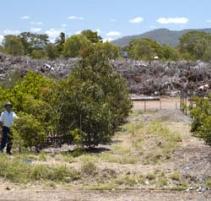CQU helps assess new way of capping rubbish dumps
Published on 11 July, 2005
CQU will be collaborating with the University of Melbourne to undertake ‘phytocapping’ research to control landfill groundwater contamination, greenhouse emissions and odour.
CQU researcher Dr Nanjappa Ashwath (pictured) is on the research team and his current work at Rockhampton's dump (see photo) will be expanded to other states with the view to testing the effectiveness of this environmentally-friendly technique of landfill remediation.
Dr Ashwath has acknowledged assistance of Rockhampton Mayor Cr Margaret Strelow and council officer Craig Dunglison in establishing the trial site at the dump.
 The CEO of the Waste Management Association of Australia (WMAA), Ms Val Southam, has announced that an Australian Research Council grant of $734,000 to the University of Melbourne will allow a $3 million, five-year, national research program to commence in early 2006.
The CEO of the Waste Management Association of Australia (WMAA), Ms Val Southam, has announced that an Australian Research Council grant of $734,000 to the University of Melbourne will allow a $3 million, five-year, national research program to commence in early 2006.
The industry/ARC-funded ‘Australian Alternative Covers Assessment Program’ will evaluate and further develop a new, planted soil capping technology for landfills known as ‘phytocapping’ (‘phyto’ = plant).
The program will be conducted at five sites. It will determine where phytocaps can perform more effectively, sustainably and economically than conventional landfill caps under Australian conditions, conduct innovative research to further develop the technology and prepare practical guidance for its design and permitting at Australian landfills. Ms Southam explained that ‘landfills remain the major means of waste disposal in Australia and are a significant potential source of environmental contamination if not managed appropriately.
Conventional landfill covers such as compacted clay caps control percolation of rainfall into the landfill waste zone by acting as low permeability “raincoats”.
Unfortunately they can deteriorate and leak, which in turn produces landfill leachate and, therefore, potential for groundwater contamination. It is difficult, expensive and often impossible to repair these leaks’.
She added that ‘phytocaps, in contrast, work with rather than against the forces of nature. They function as 'store and pump' mechanisms – an earth layer typically about a metre in depth stores water during rainfall events and the plants then act as 'solar pumps' to remove the stored water through plant transpiration.
This mechanism can provide a more effective and less expensive alternative for controlling percolation. Moreover, because phytocaps are living systems they can 'self-repair' any faults that might begin to develop – they are more sustainable.
An important additional environmental benefit is that phytocaps can reduce landfill greenhouse gas emissions, which are an estimated 3.6 per cent of net national emissions, by oxidising the escaping methane and other anaerobic gases. The same mechanism can also reduce odour impacts on neighbouring communities. Phytocap systems can also provide more natural environments, with higher levels of community acceptance. Phytocaps may provide a particularly cost-effective alternative for rural landfills.
Ms Southam said that the program will be jointly funded by the ARC grant, landfill siteowners and the several participating research organisations.
 Mr Richard Yeates and Dr Roger Stuart of PhytoLink, an Australian phytotechnology company, will manage the program for the WMAA.
Mr Richard Yeates and Dr Roger Stuart of PhytoLink, an Australian phytotechnology company, will manage the program for the WMAA.
Dr Samuel Yuen of the University of Melbourne’s Department of Civil Engineering will lead a research team of engineers, plant scientists and other researchers from a number of Australian and US universities and other research organisations.
Landfill owners, environmental regulators and contracting engineers in each of the five participating States will also participate in the program, thus ensuring that the program’s findings are understood, accepted and implemented by all of the key stakeholder groups. The research will build upon the foundations of a pioneering US Environment Protection Authority program of research and evaluation and it will involve that program’s research leaders. However the Australian Program will go beyond the US research in important respects, particularly in the areas of plant selection, gas control and interactions between water percolation and gas control issues.
The cost-effectiveness of phytocaps depends on a combination of climate, soil and plant characteristics and is consequently locality-dependent. The research program will therefore evaluate phytocap performance across a wide range of Australian locations with different characteristics.
An important program output will be a guidance manual on phytocap design, permitting and construction. This will greatly enhance the transfer of the research findings into industry and environmental regulatory practice.

